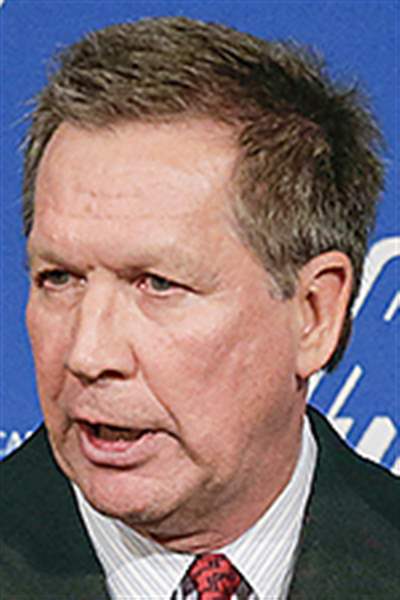
Ohio job stats leave lots of room for spin
Left, right weave clashing narratives
7/20/2014
Kaisch
ASSOCIATED PRESS

Kaisch
COLUMBUS — Recent national attention given to Republicans’ selection of Cleveland for its 2016 convention touted Ohio’s economic “turnaround.”

FitzGerald
Ohio’s June unemployment rate, announced Friday, held steady at 5.5 percent, below the national average of 6.1 percent. That allows Republicans to boast that it’s at its lowest level since April of 2007, a year before the official start of the national recession.
Democrats, however, counter that the drop in the number of people considered unemployed resulted to a large extent from job seekers falling out of the work force at a faster clip than new jobs are added.
And they’re both right.
The seemingly at-odds numbers allow Republican Gov. John Kasich and Democratic challenger Ed FitzGerald to simultaneously paint very different but still accurate pictures of the same Ohio economy as they make their cases to voters.
“To go from 350,000 lost jobs to over 250,000 new jobs is pretty good," Mr. Kasich said Thursday following an official event in Toledo. “I'm never satisfied. But I'm pleased with where we are."
He has often said the nation is watching Ohio.
But Mr. FitzGerald, Cuyahoga County executive, argues no objective economic study suggests Ohio is leading the country or has recovered from the recession. The nation as a whole recently recovered the last job lost from the start of the recession nearly six years ago and so have a number of individual states.
“We’re not one of them,” Mr. FitzGerald said. “Last estimate I saw we were 120,000 jobs short … Our [gross domestic product] growth rate in 2013 was less than it was in 2010.”
New numbers released on Friday for June, the five-year anniversary of the start of the national economic recovery, again provided ammunition for both sides. Ohio added 12,700 nonfarm jobs in June. The state’s unemployment rate held steady with 316,000 considered to be actively looking for work. That was down 1,000 from the prior month.
But the bleeding continued in terms of people dropping out of the job-search market, a national phenomenon. Whether it’s because job seekers threw up their hands in frustration, aged out of the system, or left for some other reason, Ohio’s labor force has been shrinking for a while.
The civilian labor force participation rate in June was 62.9 percent, down from 63.0 percent the prior June and 65.7 percent in June, 2010, when Ohio was in the early stages of post-recession recovery before Mr. Kasich took office.
“Clearly, we are seeing job growth, but we do have large labor force declines,” said Greg Lawson, policy analyst for the free-market Buckeye Institute for Public Policy Solutions. “There is the argument of whether the unemployment rate is the best way of looking at [Ohio’s economic progress].
“It’s disingenuous to say that’s not good, but we have to be careful not to be too Polyanna-ish about this,” he said.
An analysis of states’ May jobs numbers conducted by the W.P. Carey School of Business at Arizona State University showed that Ohio had dropped to 38th in the nation in terms of job creation as a percentage of its job market, below the national average and just ahead of Michigan, over the prior 12 months.
“Over the last 12 months, we’ve had a 1 percent job-growth rate,” said Hannah Halbert, researcher with Policy Matters Ohio, a nonprofit organization focused on the economic impacts on middle-class and lower-income workers.
“The U.S. rate was 1.8 percent,” she said. “We’ve not broken average. ... The U.S. broke its recovery threshold in May [in terms of the raw number of jobs]. They are adding on jobs. ... The U.S., since the recovery began, is at 0.3 percent, which is not great either. But if you look at Ohio, we’re still down. We’re at a negative 2.1 percent.”
Ohio is down 112,000 jobs below where it was before the recession began.
“Sure you can look at it from a glass-half-full perspective,” Ms. Halbert said. “We’ve added 12,700 jobs from May to June. That sounds really great. We like to see those numbers. ... We’ve added 262,000 jobs [since the recovery began], which sounds spectacular, but that’s over the course of five years. We’re still down six figures.”
Still, no matter how you look at the numbers, Mr. Lawson said the state has clearly made progress.
“When you see how badly Ohio had done, the real hemorrhaging of jobs in the last decade, this is definitely a much better place to be in and there are things to build on,” he said. “But we have to be careful not to just say that we’re better than we were when we were at the bottom of the pit. We still have a lot of work to do.
“Unfortunately, what we have in politics is a much simpler debate that can obscure all of the nuances,” he said. “It’s in the nuances where we learn what we need to do to make better policies.”
Staff writer Tom Henry contributed to this report.
Contact Jim Provance at: jprovance@theblade.com or 614-221-0496.